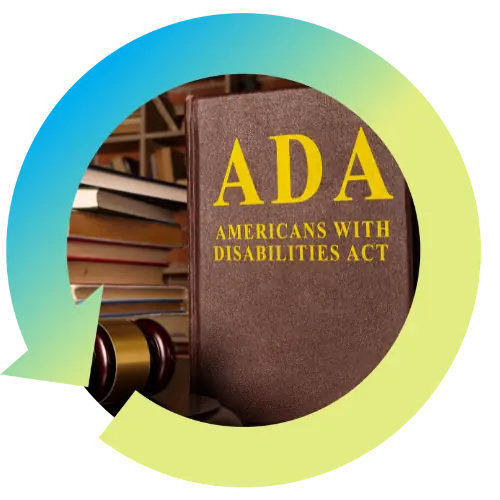Understanding ADA Compliance: A Comprehensive Guide for Businesses
March 26th, 2024

Navigating the intricacies of the Americans with Disabilities Act (ADA) can be challenging for businesses, yet it’s crucial for ensuring legal compliance and fostering an inclusive workplace environment.
As the first blog in this series, we embark on a detailed exploration of the ADA, shedding light on its various components. In the following series, we will examine the Leave Request Jungle and learn about reasonable accommodations. This series will give you a powerful tool to uphold ADA standards within your organization, support your employees, and foster a culture of inclusivity.
What is the ADA?
Enacted in 1990, the ADA is a landmark civil rights law that prohibits discrimination against individuals with disabilities in various areas, including employment, public accommodations, transportation, and telecommunications. Under the ADA, businesses are mandated to provide reasonable accommodations to qualified individuals with disabilities, ensuring equal access to opportunities and facilities.
What organizations does the ADA apply to?
The ADA applies to virtually all employers with 15 or more employees, including private businesses, state and local governments, labor unions, and employment agencies. Additionally, Title I of the ADA specifically addresses employment practices, ensuring equal opportunities for individuals with disabilities throughout the employment lifecycle.
Employment practices covered:
The ADA regulates various aspects of employment practices, including recruitment, hiring, promotion, training, lay-off, pay, firing, job assignments, leave, and benefits. Employers must ensure that individuals with disabilities are not subjected to discrimination at any stage of the employment process.
Who is protected by the ADA?
The ADA protects individuals with disabilities, defined as those who have physical or mental impairments that substantially limit one or more major life activities. Major life activities encompass a broad range of functions, including hearing, speaking, walking, working, thinking, performing manual tasks, seeing, breathing, learning, concentrating, communicating, and interacting with others.
Examples of physical and mental impairments covered by the ADA include blindness, deafness, cancer, cerebral palsy, HIV infection, schizophrenia, learning disabilities, and autism, among others.
A “qualified individual” under the ADA:
To qualify for protection under the ADA, an individual must meet the job requirements for education, experience, skills, licenses, and other qualifications. Additionally, they must be able to perform essential job functions with or without reasonable accommodations.
Determining essential job functions:
Essential job functions are tasks that are fundamental to a job’s core responsibilities. The Equal Employment Opportunity Commission (EEOC) considers various factors, such as the actual work experience of current or former employees, time spent performing a function, and the consequences of not requiring an employee to perform a function, in determining essential job functions.
Employers will want to make sure that their job descriptions are up-to-date and accurate to establish those essential job functions.
Reasonable accommodations:
Reasonable accommodations are modifications or adjustments that enable qualified individuals with disabilities to perform essential job functions, participate in the application process, and access equal employment benefits and privileges. Examples of reasonable accommodations include modifications to the work environment, job restructuring, flexible schedules, and assistive technologies.
Undue hardship:
While employers are required to provide reasonable accommodations, they are not obligated to do so if it imposes an undue hardship on the business. Factors considered in determining undue hardship include the cost of the accommodation, financial resources of the business, and the nature of the business operations.
Pre-employment process and the ADA:
During the pre-offer process, employers are prohibited from asking disability-related questions or conducting medical examinations. This ensures that hiring decisions are based on qualifications and merit rather than disability status.
Conclusion
In conclusion, understanding ADA compliance is essential for businesses committed to fostering an inclusive and equitable workplace environment. By adhering to ADA standards, organizations can cultivate a culture of diversity, respect, and equal opportunity for all employees. By embracing the principles of the ADA, businesses not only fulfill their legal obligations but also harness the talents and abilities of individuals with disabilities, driving innovation, and success in the modern workforce.
The team at MP-HR can help ensure your business is ADA compliant with the help of our leading HR software. Schedule a demo and learn how it’s done today.
Recent Posts
- Building a High-Impact Leadership Development Strategy: A Step-by-Step Guide
- Why Leadership Training Matters in 2025 and Beyond
- The Real Reason Your New Hires Quit (And How to Fix It with Smarter Onboarding) – Zip Drive INCLUDED
- Learn & Grow: The Learning Management System for Employee Engagement and Retention
- From Attic to Innovation: Jason Maxwell’s HR Leadership Journey
Categories
- ACA (10)
- AI (6)
- BizFeed (6)
- Business Strategy (119)
- COBRA (5)
- Compliance (202)
- COVID-19 (92)
- Diversity (12)
- eBooks (19)
- Employee Engagement (33)
- Employee Handbooks (24)
- ERTC (29)
- FFCRA (7)
- HR (306)
- MP Insider (13)
- Payroll (122)
- PFML (9)
- PPP (24)
- PTO (5)
- Recruiting (53)
- Remote Work (39)
- Return to Work (32)
- Unemployment (1)
- Wellness (22)
Archives
- May 2025
- April 2025
- March 2025
- February 2025
- January 2025
- December 2024
- November 2024
- October 2024
- September 2024
- August 2024
- July 2024
- June 2024
- May 2024
- April 2024
- March 2024
- February 2024
- January 2024
- December 2023
- November 2023
- October 2023
- July 2023
- June 2023
- May 2023
- April 2023
- March 2023
- January 2023
- December 2022
- October 2022
- September 2022
- August 2022
- July 2022
- June 2022
- May 2022
- April 2022
- March 2022
- February 2022
- January 2022
- December 2021
- November 2021
- October 2021
- September 2021
- August 2021
- July 2021
- June 2021
- May 2021
- April 2021
- March 2021
- February 2021
- January 2021
- December 2020
- November 2020
- October 2020
- September 2020
- August 2020
- July 2020
- June 2020
- May 2020
- April 2020
- March 2020



